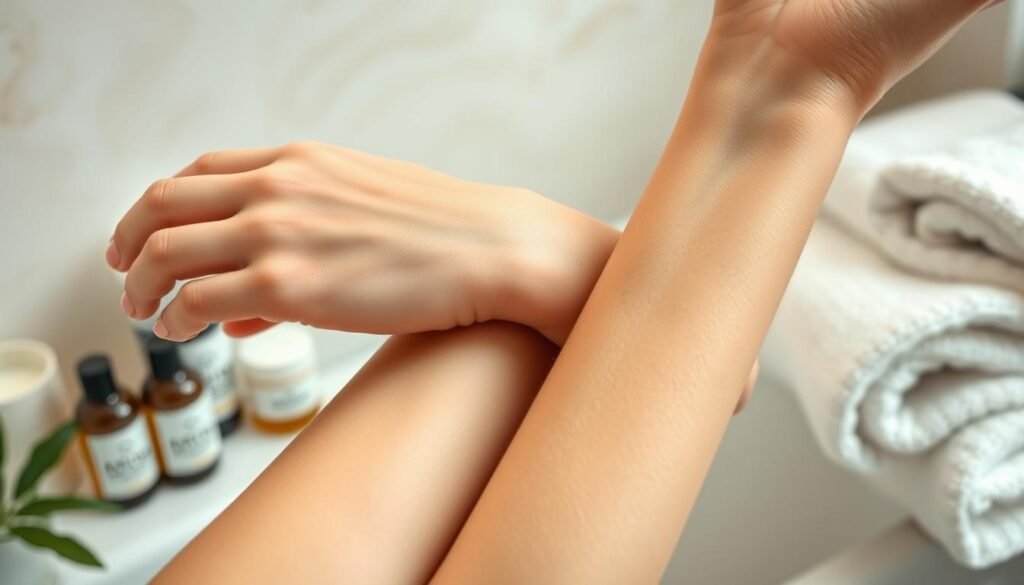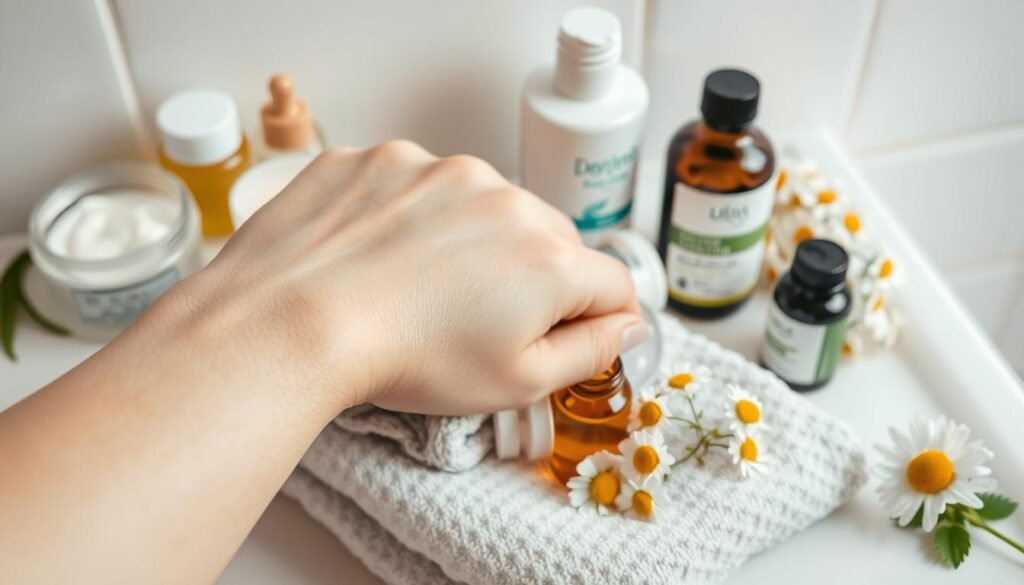Did you know that up to 80% of people with curly hair get *ingrown hairs in the armpit* from shaving? This leads to folliculitis on the arms. Folliculitis is an inflammation of hair follicles that causes breakouts and discomfort. If you understand how to handle arm folliculitis, you can lessen irritation and get healthier skin. This article will cover the causes, symptoms, and treatments for arm folliculitis. We’ll provide expert tips to help you get clear and comfortable skin.
Key Takeaways
- Folliculitis on arms can come from different things, like damaged hair follicles and bacteria.
- Signs are discolored bumps, pimples with pus, and itching.
- Keeping a good skincare routine and avoiding irritants can prevent arm folliculitis.
- Antibacterial washes that you can buy without a prescription can work well.
- If your case is severe or keeps coming back, see a dermatologist.
- Choosing the right clothes and ways to remove hair can lower your risk of getting folliculitis.
Understanding Folliculitis on Arms
Folliculitis is a skin issue that affects hair follicles mainly on the arms. It shows up as small red bumps or pustules. Knowing about it is key to treating it well.
What is Folliculitis?
This condition means your hair follicles are inflamed or infected. You might see red bumps or blisters filled with pus. It often itches or feels uncomfortable. Staphylococcus aureus bacteria is a common cause. Hot tub folliculitis comes from a different bacteria in poorly cleaned pools or spas.
How Folliculitis Differs from Other Skin Conditions
Folliculitis is different from acne or eczema. Acne comes from blocked pores, while folliculitis is an infection around hair follicles. Knowing the difference helps in treating them right.
| Condition | Cause | Symptoms | Treatment |
|---|---|---|---|
| Folliculitis | Bacterial infection | Red bumps, pustules | Topical antibiotics, bleach baths |
| Acne | Clogged pores | Blackheads, whiteheads, cysts | Retinoids, benzoyl peroxide |
| Eczema | Allergic reaction, irritants | Dry, itchy, inflamed skin | Moisturizers, corticosteroids |
Common Causes of Folliculitis on Arms
It’s important to know what causes folliculitis on your arms to treat it right. Many things can cause this skin problem. They affect hair follicles and make your skin irritated.
Hair Follicle Damage
Simple everyday activities can damage hair follicles. Using old or dull razors can hurt your skin, making it easy for germs to get in. Tight clothes can trap sweat and rub your skin the wrong way.
These things make it easy for folliculitis to start on your arms.
Bacterial Infections and Irritation
Bacteria are often to blame for folliculitis. Staphylococcus aureus is a germ that many people have on their skin. It can cause trouble if it gets into hair follicles, especially after shaving.
There’s also “hot tub” folliculitis. This happens when you’re in water that’s not clean. It leaves you with painful, itchy bumps.
Friction and Skin Trauma
Things that rub against your skin can also cause folliculitis. Carrying backpacks or wearing tight sleeves can make your skin mad. Making small changes can help stop this from happening.
Lowering friction is key to avoiding annoying bumps. These changes can make a big difference in taking care of your skin.
| Cause | Description | Prevention |
|---|---|---|
| Hair Follicle Damage | Results from shaving or tight clothing. | Use clean razors and choose loose-fitting clothes. |
| Bacterial Infections | Primarily caused by Staphylococcus aureus. | Maintain a strong skin barrier and avoid touching affected areas. |
| Friction | Irritation from repeated contact with clothing or objects. | Opt for padding in backpacks and avoid rough fabrics. |
Symptoms to Look Out For
It’s key to know the signs of an arm skin infection. Many symptoms suggest folliculitis, mainly on the arms. Knowing these can help you act fast, avoiding worse problems.
Identifying Discolored Bumps
Small discolored bumps on the skin are often a sign of arm folliculitis. They might look reddish, showing that the follicles are irritated. Spotting these early helps fight skin infection.
Pus-filled Pimples and Redness
As the condition gets worse, you might see pus-filled pimples. These, along with redness, mean the hair follicles are deeply infected. Noticing this early helps get treatment sooner, stopping the problem from spreading.
Itching and Discomfort
People with arm folliculitis usually feel itching or discomfort. Scratching can make things worse by spreading the infection. Being aware of these signs is crucial for effective treatment.
Preventing Folliculitis on Arms
Keeping your arms’ skin healthy is key to avoiding folliculitis. It’s important to have a good skincare routine. This helps manage your skin and lowers your chances of getting this condition.
Proper Skincare Routine
To protect your arms from folliculitis, stick to a skincare routine. Use mild exfoliation to get rid of dead skin cells. This keeps hair follicles open. It’s also important to moisturize regularly to prevent dry skin. Make sure to pick skincare products that won’t block your pores. This will help in preventive care.
Avoiding Irritants and Allergens
Steering clear of irritants is vital in stopping folliculitis. Harsh soaps and products can remove your skin’s natural oils. This leads to irritation. Avoid tight clothes as they cause friction. Choose loose, breathable outfits instead. This significantly cuts down on skin irritation. Doing so is important for folliculitis prevention arms.
Choosing the Right Clothing
Picking the right clothes helps avoid folliculitis on your arms. Cotton and similar fabrics let your skin breathe and stay dry. Stay away from synthetic fabrics that make you sweat more. By sticking to these tips, you can help stop folliculitis from forming.

| Prevention Method | Benefits |
|---|---|
| Gentle Exfoliation | Removes dead skin cells, keeps hair follicles clear |
| Regular Moisturization | Prevents dryness and improves skin barrier function |
| Avoiding Irritants | Reduces skin inflammation and irritation |
| Loose, Breathable Clothing | Minimizes friction and sweat accumulation |
Effective Treatments for Arm Folliculitis
Finding the right treatment for arm folliculitis can really help with discomfort. It also improves skin health. Many options exist, from simple over-the-counter solutions to prescription treatments.
Over-the-Counter Remedies
Start with over-the-counter treatments for mild cases. Benzoyl peroxide washes and antiseptics fight the bacteria. They keep the skin clean and prevent more infections. Also, antibacterial soaps are great for keeping hygiene in check. This greatly cuts down on flare-ups.
Prescription Treatments
If the condition stays, see a healthcare provider for more help. Oral antibiotics like dicloxacillin kill tough bacteria. For ‘hot tub’ folliculitis, ciprofloxacin is an option. Creams like fusidic acid or mupirocin are used for treatment on the skin.
| Treatment Type | Example Medications | Frequency of Use |
|---|---|---|
| Over-the-Counter | Benzoyl Peroxide, Antibacterial Soaps | Daily as needed |
| Prescription Antibiotics | Dicloxacillin, Cefadroxil, Ciprofloxacin | As prescribed (typically multiple times daily) |
| Topical Antibiotics | Fusidic Acid, Mupirocin | Twice to three times daily |
Seeing a dermatologist is key for the best care. They create a plan just for you. This gives you the best shot at beating arm folliculitis.
Home Remedies for Managing Arm Folliculitis
Dealing with arm folliculitis at home can really change your comfort level. Many natural remedies are helpful and offer relief. They make the skin better by soothing and healing. Using these remedies often can improve your skin health a lot.
Natural Antiseptics and Soothing Agents
Natural antiseptics are key in fighting arm folliculitis. Here are some good options for your skincare routine:
- Tea Tree Oil: Tea tree oil, with its strong antibacterial effects, can cut down flare-ups by around 50% with regular use.
- Aloe Vera Gel: Aloe Vera speeds up skin healing. Studies show it can improve healing by up to 99% in just one week of use.
- Apple Cider Vinegar (ACV): Applying a mix (1 tablespoon ACV to ½ cup water) for 20 minutes, twice daily, brings relief.
- Turmeric Paste: A turmeric paste can lower inflammation by up to 40%, which helps lessen symptoms.
- Neem Oil: Neem oil, known for antiseptic and antifungal qualities, helps about 70% of users when applied nightly.
Baths and Exfoliation
Adding warm baths and gentle exfoliation to your weekly care can help manage folliculitis.
- Warm Baths: Epsom salt baths reduce irritation and aid in healing. Try to take them 2 to 3 times weekly.
- Exfoliation: Gentle exfoliation keeps hair follicles open, which prevents new breakouts. Use mild scrubs once or twice a week.
- Warm Compresses: Warm compresses applied 2 to 3 times daily can ease discomfort and improve healing.
These home remedies offer a complete way to deal with arm folliculitis. They speed up healing and bring back healthy skin. A mix of natural antiseptics, soothing agents, and baths works well for home treatment.
When to See a Dermatologist
Knowing when to visit a dermatologist can greatly help with arm folliculitis. If home remedies don’t work, you might need a pro. It’s key to catch severe cases early for the best treatment.
Identifying Severe Cases
Look out for signs of a big problem:
- Persistent or worsening pain
- Large, painful pus-filled lumps
- Fever or chills indicating systemic infection
If you see these symptoms, getting medical help is critical. A skin doctor can check if you need special care.
Specialist Treatment Options
For arm folliculitis, doctors may suggest different treatments:
| Treatment Type | Description |
|---|---|
| Antibiotic Lotions | These work for mild bacterial issues; serious cases might need pills. |
| Antifungal Medications | Needed for yeast-related folliculitis, which can’t be fixed by antibiotics. |
| Steroid Creams | These are for a specific type, often seen in HIV/AIDS patients. |
| Minor Surgical Interventions | Draining big boils or carbuncles can lessen pain and scar risk. |
| Laser Hair Removal | Good for certain types, may need several tries to work. |
Getting help early and the right treatment can stop arm folliculitis from coming back. Always talk to a dermatologist for the best advice.
Folliculitis Prevention Tips for Arms
It’s key to take early action to prevent folliculitis prevention arms. The focus is on clean skin and smart grooming to avoid outbreaks.
Maintaining Clean and Dry Skin
Clean, dry skin is critical in stopping folliculitis. Wet skin can worsen the condition, so it’s important to:
- Shower often, especially after a workout or sweating.
- Use antibacterial soap to keep bacteria at bay.
- Pat your skin dry carefully to avoid rubbing too hard.
- Use a light moisturizer that won’t block pores.
Effective Hair Removal Techniques
How you remove hair matters in preventing folliculitis. The right methods prevent clogged pores and irritation:
- Choose clean, sharp razors made for your skin.
- Shave in the hair’s growth direction to reduce irritation.
- Don’t shave over irritated or folliculitis-affected areas.
- Think about using hair removal creams or laser treatments as safer options.

| Tip | Description |
|---|---|
| Shower Regularly | Keeps sweat and bacteria off your skin. |
| Use Antibacterial Soap | Lowers the chance of bacteria and infections. |
| Pat Dry | Avoids harm from harsh towel rubbing. |
| Shave Properly | Lessens skin trouble and ingrown hairs risk. |
| Explore Alternatives | Laser removal offers a gentler way out. |
Understanding Recurrence of Folliculitis
To manage arm folliculitis well, you have to know why it comes back. A lot of people find it hard to understand why these breakouts return. It often comes back due to irritants or skin issues that don’t go away. It’s important to look at your hygiene, how sensitive your skin is, and your daily habits.
Why It Keeps Coming Back
The reason folliculitis returns involves a few factors:
- Improper skincare: Not keeping your skin clean and moist can lead to more outbreaks.
- Underlying conditions: Issues like hormonal imbalances or skin sensitivities can keep the problem going.
- Friction: Wearing certain clothes and some activities can irritate your skin and cause breakouts.
- Infectious agents: Bacteria, such as Staphylococcus aureus, are often behind the worse types of folliculitis.
Long-Term Management Strategies
To lower the chance of folliculitis coming back on your arms, try these steps:
- Medicated cleansers: Using these regularly can help your skin stay clear of bacteria.
- Hydration: Keeping your skin moist is key to stopping irritation and flare-ups.
- Consultation with dermatologists: A skin doctor can offer helpful advice and create care plans that suit you.
- Avoiding occlusive clothing: Clothes that keep heat and moisture in can make Malassezia folliculitis worse.
By knowing why folliculitis keeps coming back and using consistent steps to manage it, you can greatly cut down the chance of having breakouts on your arms. For deeper insights into the types and characteristics of folliculitis, checking expert articles like the clinical overview on folliculitis is useful.
| Factor | Impact on Recurrence |
|---|---|
| Improper Skincare | Increases skin irritability |
| Underlying Conditions | Can exacerbate symptoms |
| Friction from Clothing | Triggers breakouts |
| Infectious Agents | Contributes to deep folliculitis |
Debunking Myths about Folliculitis
Folliculitis is often misunderstood, which leads to myths that can block effective treatment. Some think not washing well causes it, while others believe it only hits those with oily skin. These wrong ideas can make treatment fail and stop people from getting the right help.
Common Misconceptions
- Folliculitis is solely a result of poor cleanliness.
- It only occurs in people with excessively oily skin.
- Folliculitis is contagious and can be easily spread.
- Only young people can suffer from this skin condition.
Fact vs. Fiction
Knowing the truth about folliculitis is key to treating it correctly.
| Myth | Fact |
|---|---|
| Poor hygiene causes folliculitis. | Folliculitis can strike clean people; damaged hair follicles or infection are to blame. |
| Only oily skin can be affected. | All types of skin can get folliculitis, no matter how oily. |
| Folliculitis is contagious. | It doesn’t spread; clogged hair follicles or bacterial infections cause it. |
| Only young people are affected. | Anyone, at any age, can get folliculitis. |

By clearing up these myths, people can find more effective treatments for arm bumps. Being well-informed helps manage the condition better and decreases its occurrence.
Staying Informed About Skin Conditions
Learning about skin conditions helps us manage them better. Knowing about folliculitis means we can take care of our skin before problems start. Finding support offers information and help to those struggling with this common issue.
Resource and Support Groups
Joining support groups for folliculitis can really help. They provide:
- Information on symptoms and treatments
- Advice on prevention strategies
- Access to communities experiencing similar conditions
Importance of Education
Learning about skin conditions is powerful. Understanding risks, like being overweight, diabetes, or shaving too much, helps us prevent folliculitis. Knowing about skin health and other health issues is also crucial for getting the right treatment.
| Resource Type | Description |
|---|---|
| Online Forums | Communities focused on sharing experiences and advice regarding skin conditions. |
| Educational Websites | Reliable sources providing research and updated information about folliculitis and related skin conditions. |
| Local Support Groups | In-person gatherings for discussion and support among individuals facing similar challenges. |
Conclusion
Managing folliculitis on arms needs a good understanding. It’s key for effective care and stopping it before it starts. Knowing the causes, like bacteria and skin injury, helps people avoid outbreaks. With the right skincare and avoiding what irritates the skin, many can have smoother skin.
For those with ongoing symptoms, finding the right treatment is important. There’s a range of treatments available, from store-bought to doctor-prescribed. Experts believe that careful, quick action can make a big difference in skin health.
Achieving clear arms is possible with the right steps and knowledge. People should learn about the condition and find what works for them. For more info on skin infections and tips, visit this helpful resource. It offers advice on treatment and highlights the need for a proper diagnosis.
